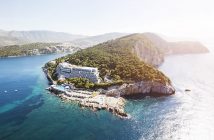As if sketched by a wandering god’s idle hand, Turkey’s Datça Peninsula juts between myth and modernity. Teresa Levonian Cole escapes to D Maris Bay – a sanctuary of sybaritic indulgence and sunlit serenity – where Aphrodite’s legacy lives on in marble, mezze, and mischievous cocktails…
Like an arm extended to divide the waves of the Aegean, to the North, and the Mediterranean, to the South, the Datça Peninsula points into the sea from the filigree coast of southwest Turkey, to wag an admonitory finger at Greece. At the tip of the peninsula sits the ancient Hellenic city of Knidos, a short hop from Hippocrates’ island of Kos. Hereabouts, according to legend, Aphrodite, the Greek goddess of Beauty and Love was born – fittingly enough, given the enduring allure of this craggy, pine-clad coastline bordering impossibly turquoise hues.
But I am to head further East along this 50-mile peninsula, to where the D Maris Bay perches, in splendid isolation, on a forested granite cliff overlooking a vast bay. My misgivings about over-development in the area were quickly dispelled: the land is protected, saving it from the depredations suffered by Bodrum and Dalaman, from which the hotel is roughly equidistant (around 2 hours by car – though many guests choose to arrive by helicopter). And I am struck, as we wind down through this natural paradise, by the smell of pines, the trilling of birds, and the brilliant pink oleander – ubiquitous in this part of the world, both for its decorative value and as a deterrent to goats.
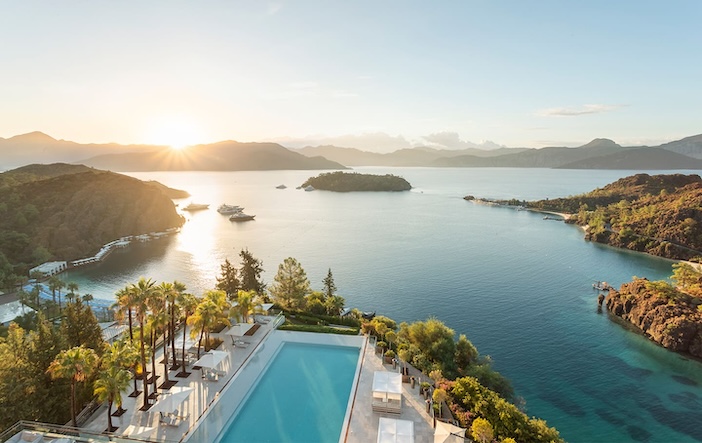
Once in the lobby, I hardly see the vast arrangement of peonies, or the collection of sculptures by Turkish artist, Ahmet Güneştekin: the pull of the light is too strong, and I am drawn to the terrace for welcome cocktails above an endless blue – the 30 by 20 metre turquoise pool, beyond which lie the flawless sapphires and jades of the Mediterranean.
Instantly, I feel at home. This is partly down to the warmth of the hospitality, to the beauty of the natural setting, and the attention to detail. My room, with open vistas over the bay, the yachts moored at a comfortable distance, and the long stretch of five private beaches (six, if you count the sole-use romantic beach), is entirely of natural materials.
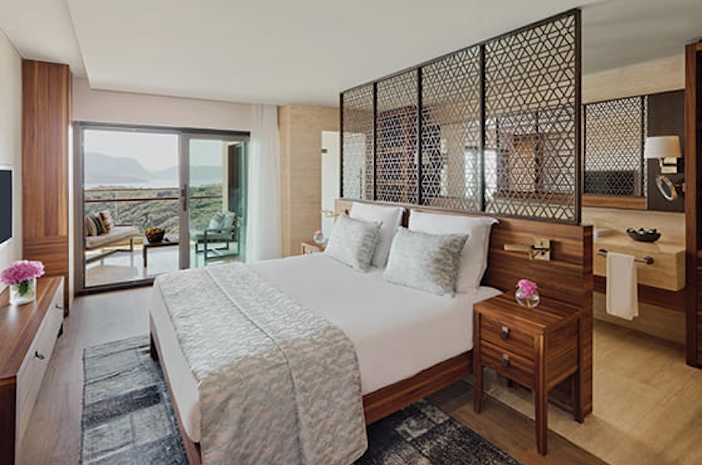
Solid walnut floors and furniture (no whisper of veneer here!) marble bathrooms with light-filled views from the bathtub, and a metalwork screen redolent of Islamic motifs form the structure. And, on the subject of structure, I notice that, clad entirely in marble, the hotel is angled like a recumbent bucket, and with receding levels, so that its full mass (containing 196 rooms and suites) is visible only from the sea.
Days are spent ricocheting between the hotel’s beaches, bars, and restaurants. Beaches – with their spotlessly clean, talc-like sand imported from Egypt (it’s softer than the local variety) – are reached either by buggy or by an efficient boat shuttle with leather seats and a snout like an amphibious landing vehicle to speed disembarkation. Each beach has a distinct character and its own dining outlet complete with signature cocktails. La Guérite, for example – which originated in St. Tropez and also has an outpost in St. Barth – is party central, and beloved of millionaire yacht owners who swan into the bay in search of fun.
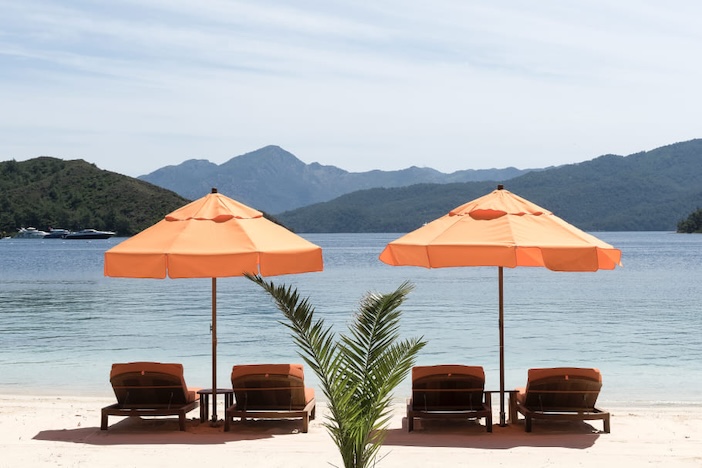
On this beach, after the unwonted exertion of kayaking, I reward myself with an ‘Alice’ – a mouth-tingling concoction of vodka, mastiha, lime juice, cucumber juice, clove sauce and fresh basil. It cues a lunch – to the sounds of a live DJ – of a feast that includes such delights as steamed shrimps with samphire and bottarga, and culminates in an enormous turbot, whose Picasso-esque physiognomy is every bit as baleful as its flesh is toothsome.
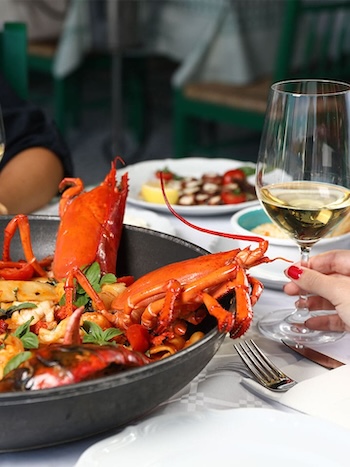 Food is key to the D Maris experience – beginning with breakfast, which ensures tastebuds are tickled from the moment you fall out of bed, with an embarras de choix: freshly-baked French and Turkish cakes and pastries, smoked fish and meats, a dozen fresh fruit and vegetable drinks, a Lebanese counter, another of local sheep and goat cheeses, socuk made of grapejuice and walnuts, and an array of freshly-prepared hot dishes, too numerous to mention. And, of course, famous Datça pine honey.
Food is key to the D Maris experience – beginning with breakfast, which ensures tastebuds are tickled from the moment you fall out of bed, with an embarras de choix: freshly-baked French and Turkish cakes and pastries, smoked fish and meats, a dozen fresh fruit and vegetable drinks, a Lebanese counter, another of local sheep and goat cheeses, socuk made of grapejuice and walnuts, and an array of freshly-prepared hot dishes, too numerous to mention. And, of course, famous Datça pine honey.
As guests are effectively gilded captives at the hotel, given its remoteness, there’s a choice of six exceptional restaurants, ranging from the meatily-skewered Turkish delights of D Maris Kitchen, to the storied Nusr-Et, and the modern Japanese delights of Zuma, for dinners. We dance one night away at Manos, which originated on the neighbouring island of Symi, to live bouzouki music and plate smashing – a practice which was outlawed in its country of origin, in 1968, thereby out-Greeking the Greeks. The food is sublime, with counters of beady-eyed fish and shellfish such as I have not seen for a very long time, accompanied by local rakı and shots of freshest sea urchin.
New this year is Aurora, at 130 years of age, Capri’s oldest (and celebrity-magnet) restaurant. Not to be missed are the trademarked Pizzallacqua – the ricotta and zucchini flower, and the mozzarella and truffle, are divine – made with the thinnest of dough. And a small lunch-time Zuma serving sushi and sashimi now also graces Silent Beach – a child-free zone so popular with adults it has, ironically, become the most gregarious of all of them. This is where – with a spicy passion fruit margarita – I soak up my last rays of sun before being delivered into the not-so-tender care of British Airways.
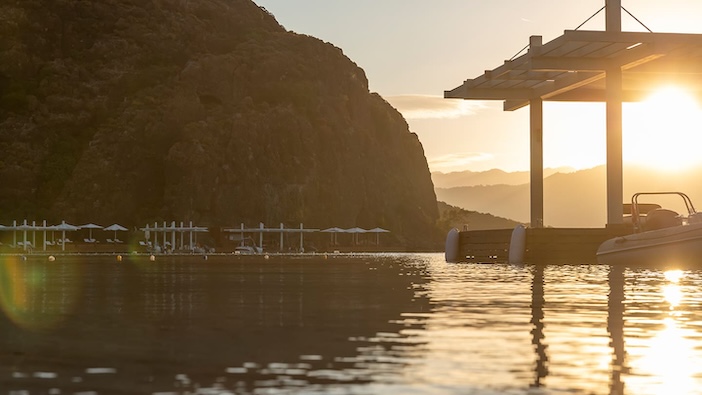
In short, barely 10 minutes pass without either a glass or a fork in the hand. When not indulging in food, or soaking in the beautiful hammam at the spa, I am tempted by a dose of retail therapy (yes, there’s that too – from chic Dior to casual Turkish designs). In fact, with the exception of a delightful afternoon spent on the hotel’s lovely 52-foot motor boat, Alia Open Sea, pottering around white granite crenelated cliffs and turquoise coves – a mountain goat here, a ruined Orthodox church there – I don’t venture beyond the hotel’s 39 acres…
…Which means that I have yet to visit Old Datça, the picturesque hilltop village of stone houses and bougainvillea or, indeed, the ruins of Knidos, once the home of Praxiteles’ statue of Aphrodite, lauded by Pliny the Elder. Clearly, I shall have to return!
For more information about D Maris Bay, including details of experiences and the Yacht Club, please visit www.dmarisbay.com.




